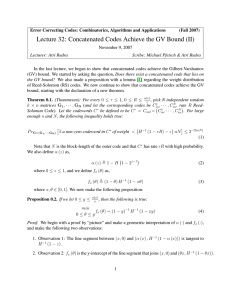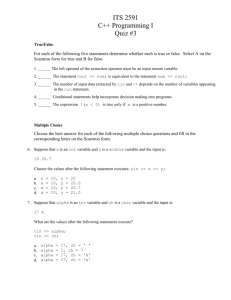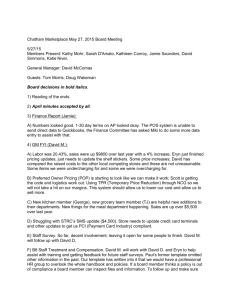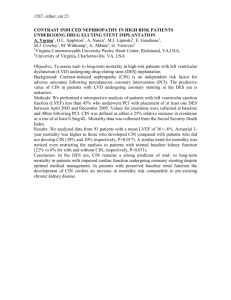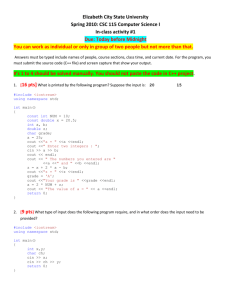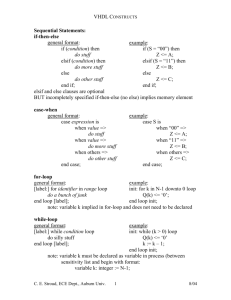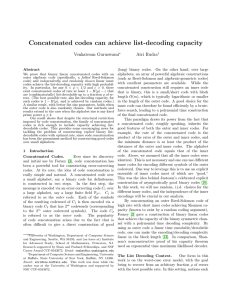Lecture 31: Concatenated Codes Achieve the GV Bound (I)
advertisement
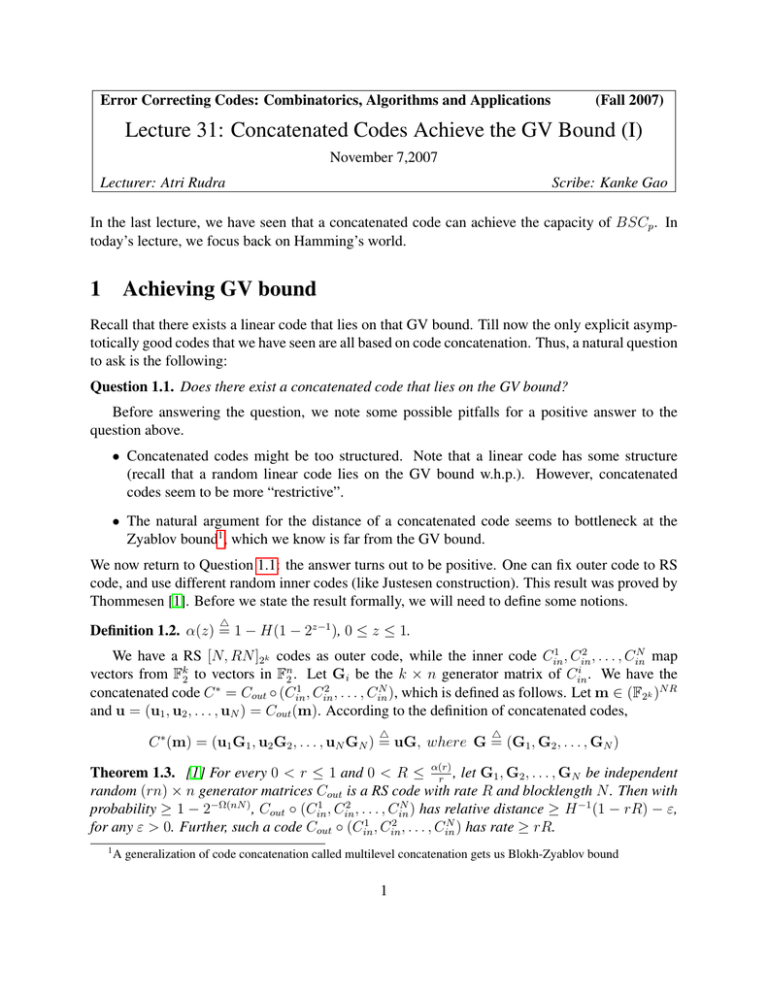
Error Correcting Codes: Combinatorics, Algorithms and Applications (Fall 2007) Lecture 31: Concatenated Codes Achieve the GV Bound (I) November 7,2007 Lecturer: Atri Rudra Scribe: Kanke Gao In the last lecture, we have seen that a concatenated code can achieve the capacity of BSCp . In today’s lecture, we focus back on Hamming’s world. 1 Achieving GV bound Recall that there exists a linear code that lies on that GV bound. Till now the only explicit asymptotically good codes that we have seen are all based on code concatenation. Thus, a natural question to ask is the following: Question 1.1. Does there exist a concatenated code that lies on the GV bound? Before answering the question, we note some possible pitfalls for a positive answer to the question above. • Concatenated codes might be too structured. Note that a linear code has some structure (recall that a random linear code lies on the GV bound w.h.p.). However, concatenated codes seem to be more “restrictive”. • The natural argument for the distance of a concatenated code seems to bottleneck at the Zyablov bound1 , which we know is far from the GV bound. We now return to Question 1.1: the answer turns out to be positive. One can fix outer code to RS code, and use different random inner codes (like Justesen construction). This result was proved by Thommesen [1]. Before we state the result formally, we will need to define some notions. 4 Definition 1.2. α(z) = 1 − H(1 − 2z−1 ), 0 ≤ z ≤ 1. 1 2 N We have a RS [N, RN ]2k codes as outer code, while the inner code Cin , Cin , . . . , Cin map k n i vectors from F2 to vectors in F2 . Let Gi be the k × n generator matrix of Cin . We have the 1 2 N concatenated code C ∗ = Cout ◦ (Cin , Cin , . . . , Cin ), which is defined as follows. Let m ∈ (F2k )N R and u = (u1 , u2 , . . . , uN ) = Cout (m). According to the definition of concatenated codes, 4 4 C ∗ (m) = (u1 G1 , u2 G2 , . . . , uN GN ) = uG, where G = (G1 , G2 , . . . , GN ) Theorem 1.3. [1] For every 0 < r ≤ 1 and 0 < R ≤ α(r) , let G1 , G2 , . . . , GN be independent r random (rn) × n generator matrices Cout is a RS code with rate R and blocklength N . Then with 1 2 N probability ≥ 1 − 2−Ω(nN ) , Cout ◦ (Cin , Cin , . . . , Cin ) has relative distance ≥ H −1 (1 − rR) − ε, 1 2 N for any ε > 0. Further, such a code Cout ◦ (Cin , Cin , . . . , Cin ) has rate ≥ rR. 1 A generalization of code concatenation called multilevel concatenation gets us Blokh-Zyablov bound 1 2 Weight distribution of RS codes The proof will require an estimate on the number of RS codewords of a given Hamming weight. We do this next. Given [N, K, D]2k RS code, let Aw (0 ≤ w ≤ N ) denote the number of codewords that have hamming weight w. Obviously, A0 = 1, Aw = 0, 1 ≤ w ≤ D. The following result follows from an exact characterization of Aw for MDS codes. However, below we give a simpler proof. (w−D+1)K 2 Proposition 2.1. Let 0 ≤ w ≤ N , then Aw ≤ N 2 . w ways to choose the non-zero-position in a codeword of Proof. Fix D ≤ w ≤ N . There are N w weight w. We will use the fact that if any K values of a codeword is fixed, then the entire codeword is determined. Note that N − w position are already fixed to be 0. So if fix t = K − (N − w) positions, fix the codeword. As K = N − D + 1, t = N − D + 1 − (N − w) = w − D + 1. W.o.l.g, fixing the “first” t positions in the non-zero position determined the codeword. Since there k(w−D+1) are ≤ 2k(w−D+1) possible such “prefixed”, Aw ≤ N 2 . w 2.1 Some other function Definition 2.2. fx (θ) = (1 − θ)−1 H −1 (1 − θx), 0 ≤ θ ≤ 1 The following property of this function will be crucial in the proof of Theorem 1.3. Lemma 2.3. For any x ≥ 0, 0 ≤ y ≤ α(x) , x min fx (θ) = fx (y). 0≤θ≤y (1) We will not formally prove this result. However, the following three facts are key in the proof of Lemma 2.3. • Fact 1: the line segment connecting (x, 0) and (α(x), H −1 (1−α(x))) is tangent to H −1 (1−r) at (α(x), H −1 (1 − α(x))). • Fact 2: H −1 (1 − r) is strictly decreasing convex function. • Fact 3:fx (θ) is the intercept of line segment through (x, 0) and (xθ, H −1 (1 − xθ)) on the y-axis. References [1] C. Thommesen. The existence of binary linear concatenated codes with reed - solomon outer codes which asymptotically meet the gilbert- varshamov bound. IEEE Trans. Inform. Theory, pages 850–853, Nov 1983. 2 This follows from exact characterization of Aw for MDS codes 2
